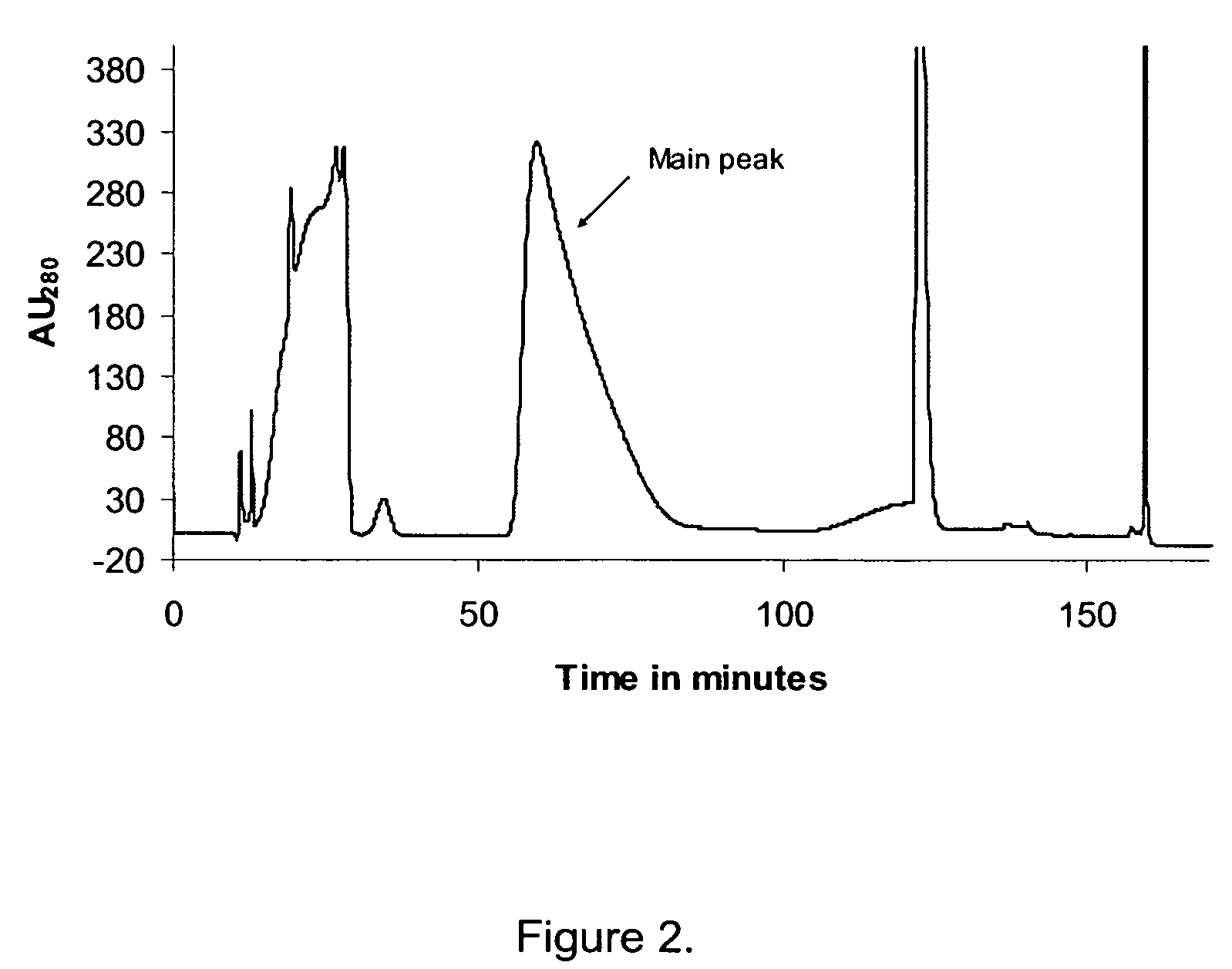Separation of polypeptides comprising a racemized amino acid
a polypeptide and amino acid technology, applied in the field of protein purification, can solve the problems of difficult separation of closely related polypeptides, limited capacity, and high cost of the process
- Summary
- Abstract
- Description
- Claims
- Application Information
AI Technical Summary
Benefits of technology
Problems solved by technology
Method used
Image
Examples
example 1
[0135]Arg34GLP-1(7-37) was expressed in yeast (S. cerevisiae) by conventional recombinant technology as described elsewhere (WO 98 / 08871). Arg34GLP-1(7-37) in the fermentation broth was then purified by conventional reversed phase chromatography and subsequently precipitated at the isoelectric pH of the peptide, i.e. at pH 5.4. The precipitate was isolated by centrifugation. Following another RP-LC purification step and isoelectric precipitation, the Arg34GLP-1(7-37) peptide was acylated as decribed in WO 00 / 55119 to give the GLP-1 derivative Arg34Lys26Nε(γ-Glu(Nα-hexadecanoyl))GLP-1(7-37).
[0136]A mixture of 0.5 g / L Arg34Lys26Nε(γ-Glu(Nα-hexadecanoyl))GLP-1(7-37) at pH 8.0 was prepared. The purity of the polypeptide was approx. 90% (approx. 5% D-His variant, D-His7Arg34Lys26Nε(γ-Glu(Nα-hexadecanoyl))GLP-1(7-37), where the histidine in position 7, i.e. the N-terminal of the peptide was racemized to a D-histidine residue, and 5% of other impurities). The mixture is purified using anio...
example 2
[0140]A mixture of 2.0 g / L (γ-Glu(Nα-hexadecanoyl))GLP-1(7-37) at pH 8 was prepared as described in example 1.
[0141]0.6 CV of the mixture was applied to a 4.7 mL Poros 20HQ (Perseptive Biosystems) anion exchanger column equilibrated with 5 CV 20 mM Tris-hydroxymethyl amino-methane, 63% (w / w) ethanol, pH 8.0. The column was washed with 6 CV equilibration solution, and the elution was performed with two linear salt gradients, the first gradient from 0-50 mM of NaCl, 20 mM Tris-hydroxymethyl amino-methane, 63% (w / w) ethanol, pH 8.0 over 12 CV, followed by the second gradient from 50-80 mM of NaCl, 20 mM Tris-hydroxymethyl amino-methane, 63% (w / w) ethanol, pH 8.0 over 20 CV. The flow was 90 CV / h and the temperature 40° C. throughout the experiment.
[0142]During the experiment the eluent from the column was fractionated and each of the fractions were analysed for the contents of D-His7Arg34Lys26Nε(γ-Glu(Nα-hexadecanoyl))GLP-1(7-37) and Arg34Lys26Nε(γ-Glu(Nα-hexadecanoyl))GLP-1(7-37), resp...
example 3
[0144]A mixture of 0.5 g / L Arg34Lys26Nε(γ-Glu(Nα-hexadecanoyl))GLP-1(7-37) at pH 8.0 is prepared as described in example 1.
[0145]0.1 CV of the mixture is applied to a 1 mL Mono Q (Amersham Biosciences) anion exchanger column equilibrated with 10 CV 20 mM Tris-hydroxymethyl amino-methane, 63% (w / w) ethanol, pH 8.0. The column is washed with 3 CV equilibration solution, and the elution is performed with two linear salt gradients, the first gradient from 0-20 mM of NaCl, 20 mM HEPES, 63% (w / w) ethanol, pH 8.0 over 20 CV, followed by the second gradient from 20-50 mM of NaCl, 20 mM HEPES, 63% (w / w) ethanol, pH 8.0 over 10 CV. The flow is 20 CV / h and the temperature 25° C. throughout the experiment.
[0146]During the experiment the eluent from the column is fractionated and each of the fractions are analysed for the contents of D-His7Arg34Lys26Nε(γ-Glu(Nα-hexadecanoyl))GLP-1(7-37) and Arg34Lys26Nε(γ-Glu(Nα-hexadecanoyl))GLP-1(7-37), respectively.
[0147]The data show that the D-His variant o...
PUM
| Property | Measurement | Unit |
|---|---|---|
| pKa | aaaaa | aaaaa |
| pKa | aaaaa | aaaaa |
| molecular weight | aaaaa | aaaaa |
Abstract
Description
Claims
Application Information
 Login to View More
Login to View More - R&D
- Intellectual Property
- Life Sciences
- Materials
- Tech Scout
- Unparalleled Data Quality
- Higher Quality Content
- 60% Fewer Hallucinations
Browse by: Latest US Patents, China's latest patents, Technical Efficacy Thesaurus, Application Domain, Technology Topic, Popular Technical Reports.
© 2025 PatSnap. All rights reserved.Legal|Privacy policy|Modern Slavery Act Transparency Statement|Sitemap|About US| Contact US: help@patsnap.com



